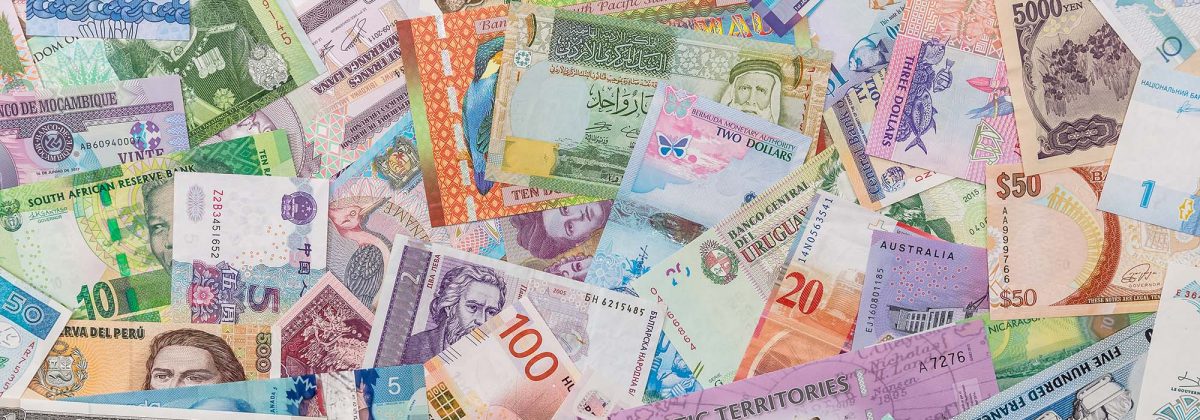5 Popular Exotic Currency Pairs in the Forex Market

There are three types of currency pairs in the forex market; major, minor and exotic currency pairs. Major currencies include the US Dollar as the base or quote currency, such as GBP/USD, EUR/USD or USD/JPY. These pairs are traded the most, and therefore have high liquidity. Next are the minors, like EUR/GBP, GBP/JPY or NZD/JPY. These do not include the US Dollar, but will have other major currencies, like EUR, GBP or AUD. The third category is the exotic. In these pairs, the US Dollar is paired with an emerging economy currency; USD/TRY (US Dollar/Turkish Lira) or USD/MXN (US Dollar/Mexican Peso).
The low liquidity in these markets make these pairs pricey when trading. As they have wider spreads compared to major and minor pairs. However, high interest rates and frequent price fluctuations may provide a chance of higher returns. These exotic currency pairs come with higher risk, so only experienced traders tend to trade them.
Here are 5 such exotic currency pairs that find themselves in a trader’s portfolio:
1. EUR/TRY (Euro/Turkish Lira)
The first exotic currency pair we are looking at is EUR/TRY. The Euro is the single currency used by 19 members of the European Union. It is the base currency in this pair. This means that if the EUR/TRY is 6.5821, it would take 6.5821 Turkish Lira to buy 1 Euro. Euro is the 2nd most heavily traded currency in the world (the US dollar being 1st). It is influenced by many factors; the geo-political crisis in the European Union and its trade partners, the monetary policy of the European Central Bank (ECB), inflation, manufacturing data and consumer demand.
The Turkish Lira (TRY) is used in Turkey, as well as the Turkish Republic of Northern Cyprus. Once known as one of the least valuable currencies in the world, TRY was revived after a wave of economic reforms in 2005. However, extensive debt crisis and current account deficit in the country led to its devaluation by more than 40% against the US Dollar in 2018.
Turkey is one of the emerging nations. Their main exports consist of farming goods and vehicles. Traders have been attracted to this pair due to its high volatility in pre-crisis times. However, this has since declined, due to the Eurozone’s strong monetary policies to keep price stability in the area.
2. GBP/ZAR (Pound Sterling/South African Rand)
The second exotic currency pair is the GBP/ZAR. This pair relies heavily on the Bank of England’s interest rate decisions. A decrease in interest rate by the British central bank can lead to high volatility. The 2016 Brexit vote led to the currency pair falling to its lowest since 2013.
In early years, the value of the Rand was closely tied to gold prices, South Africa’s biggest export. In the 2008 financial crisis, it lost almost 50% against the US Dollar.
The Rand’s relationship to gold prices continues to date. Mining of gold and platinum makes up one of their major revenue streams, along with agriculture. However, both these sectors remain troubled by political concerns and weather issues. South Africa has a thriving banking sector, along with a booming manufacturing industry. The automotive industry accounts for 10% of its exports. Traders should be wary of the country’s unemployment rates which are around 30%, one of the highest globally. The South African Reserve Bank (SARB) is focused on two main factors; the country’s high inflation and unemployment rate.
3. AUD/MXN (Australian Dollar/Mexican Peso)
The third exotic currency pair is the AUD/MXN. The Australian Dollar is a commodity currency and very volatile. Australia is a major exporter of many goods; iron ore, beef, oil, gold and many precious commodities. The seasonal price changes of these goods affect the AUD too. As there is high interest rate differential between these two currencies, the pair is often used in carry trades.
The Mexican economy is the 15th largest in the world in nominal GDP terms. It is a highly export based economy. Over 90% of its trade is done through Free-Trade agreements with more than 40 countries such as countries in the EU, Japan, Israel, Canada and the United States. Factors that impact the price direction of MXN are trade related events and reports. These include; tariff wars, supply-chain disruptions and developments in the North American Free Trade Agreement (NAFTA). FX traders look at these factors closely to make their decision.
4. USD/THB (US Dollar /Thailand Baht)
The fourth exotic currency pair is the USD/THB. The pair performed really well in 2019, despite declining US-China relations and a global slowdown. The Thai Baht is one of the few emerging economy currencies that have shown the least response to the downturn in the Chinese economy. This has made the USD/THB pair a safe haven asset, whenever there are any trade talks between the US and China.
Thailand’s safe and low-yielding bonds, large current account surplus and foreign exchange reserves have helped in driving the Baht’s value. As a result, Thailand is the 8th largest economy of Asia and has some of the lowest unemployment rates in the world. They have a wide variety of exports which include; electronics, machinery and wood. Due to this they have many trading partners. Some of these partners have some of the largest economies in the world, they include; the US, Hong Kong, China and Japan. The Bank of Thailand’s monetary policy effects the Thai Baht as well.
5. JPY/NOK (Japanese Yen/Norwegian Krone)
The fifth exotic currency pair is the JPY/NOK. The Japanese Yen’s low borrowing costs makes it popular for traders across the world. It is a safe-haven currency, when traded with the US Dollar. The Yen is also a popular carry trade currency.
The Norwegian economy is heavily reliant on oil exports. When oil prices go up, the Krone follows. Norway is a prime exporter of petroleum-based products, metals, chemicals. They ship to countries like Germany, France, the United Kingdom and United States. With its close proximity to the North Sea oil, traders could often find relations between GBP and NOK.
To conclude, exotic currency pairs should be traded with a lot of care since they lack market depth. Political unrest in these emerging nations also makes them extremely volatile.
Reference Links
- https://www.currenciesdirect.com/en/currency-tools/currency-charts/gbp-zar
- https://en.wikipedia.org/wiki/Economy_of_Turkey
- https://en.wikipedia.org/wiki/Economy_of_South_Africa
- https://www.investopedia.com/terms/e/exotic_currency.asp
- https://www.bloomberg.com/news/articles/2019-09-29/real-ruble-among-em-currencies-to-watch-in-event-of-trade-deal
- https://en.wikipedia.org/wiki/Economy_of_Thailand
- https://en.wikipedia.org/wiki/Economy_of_Norway







